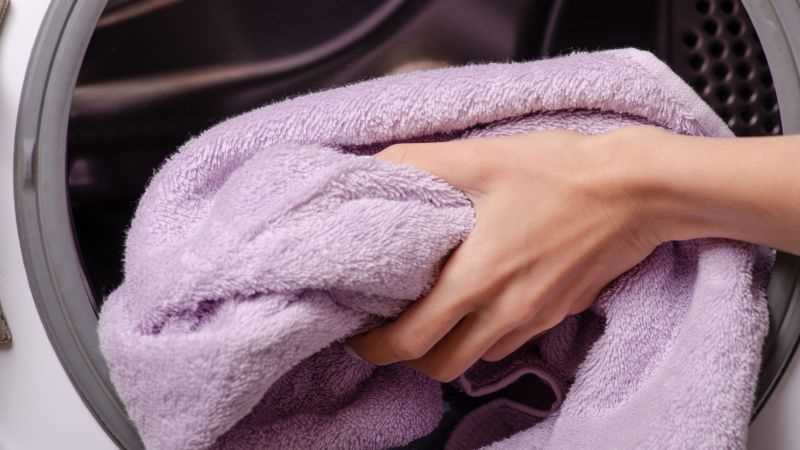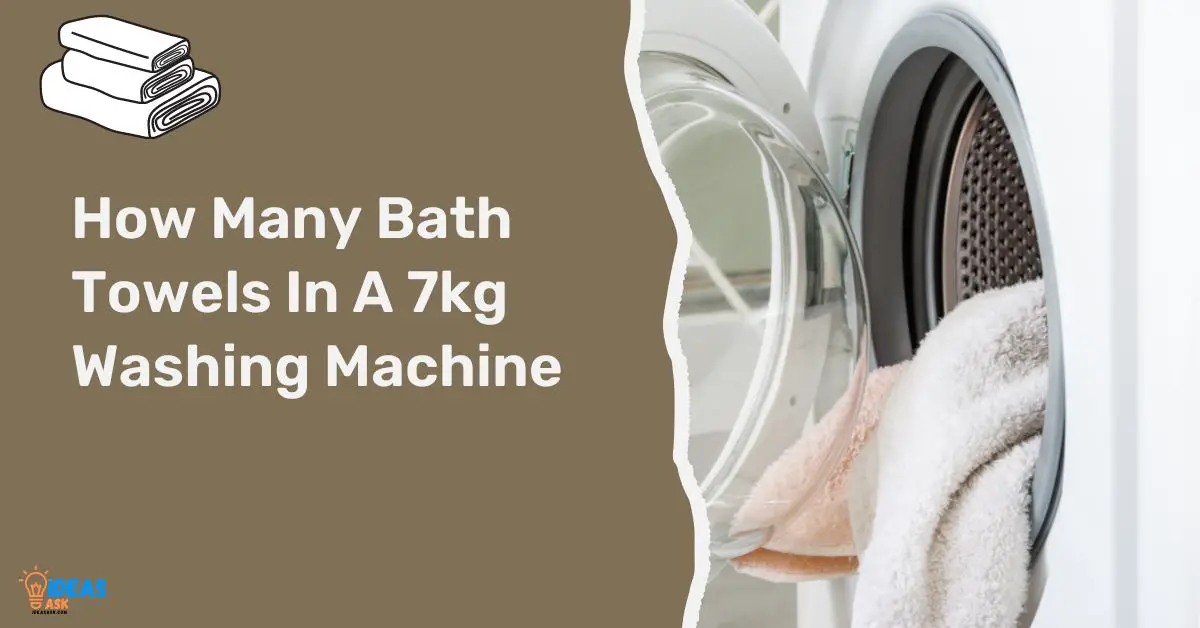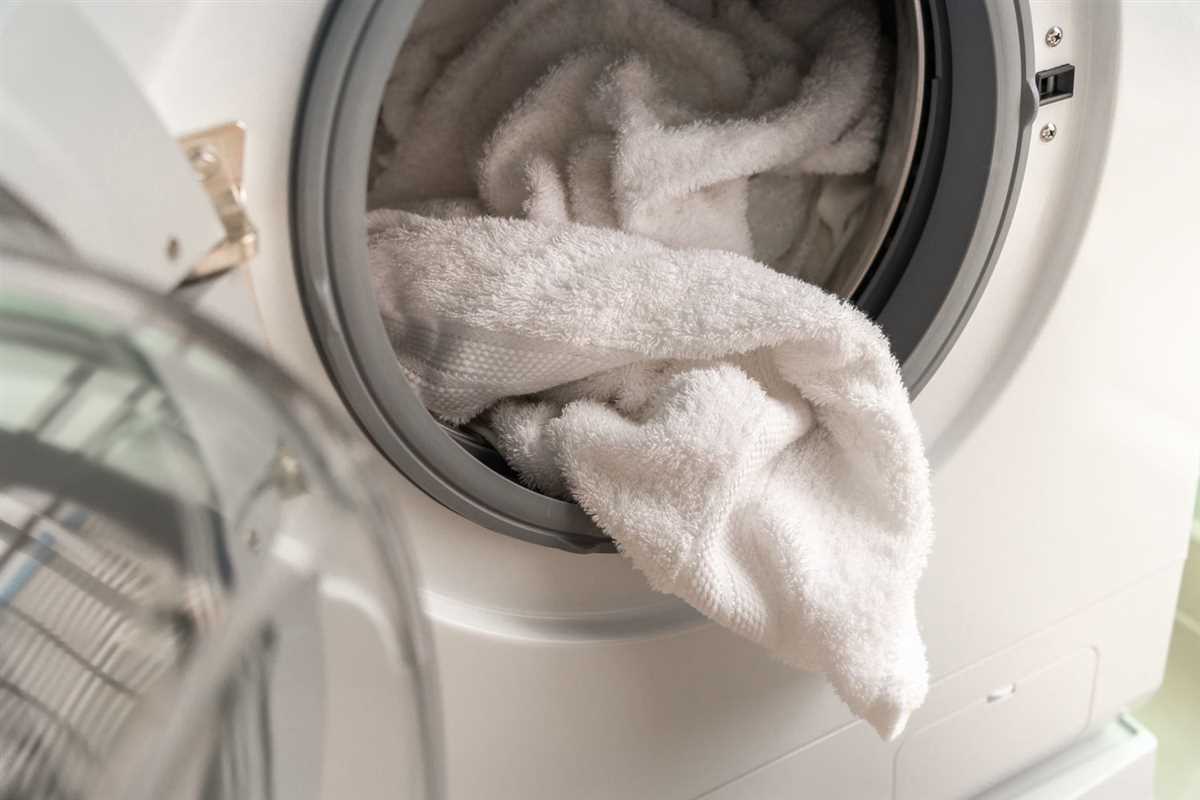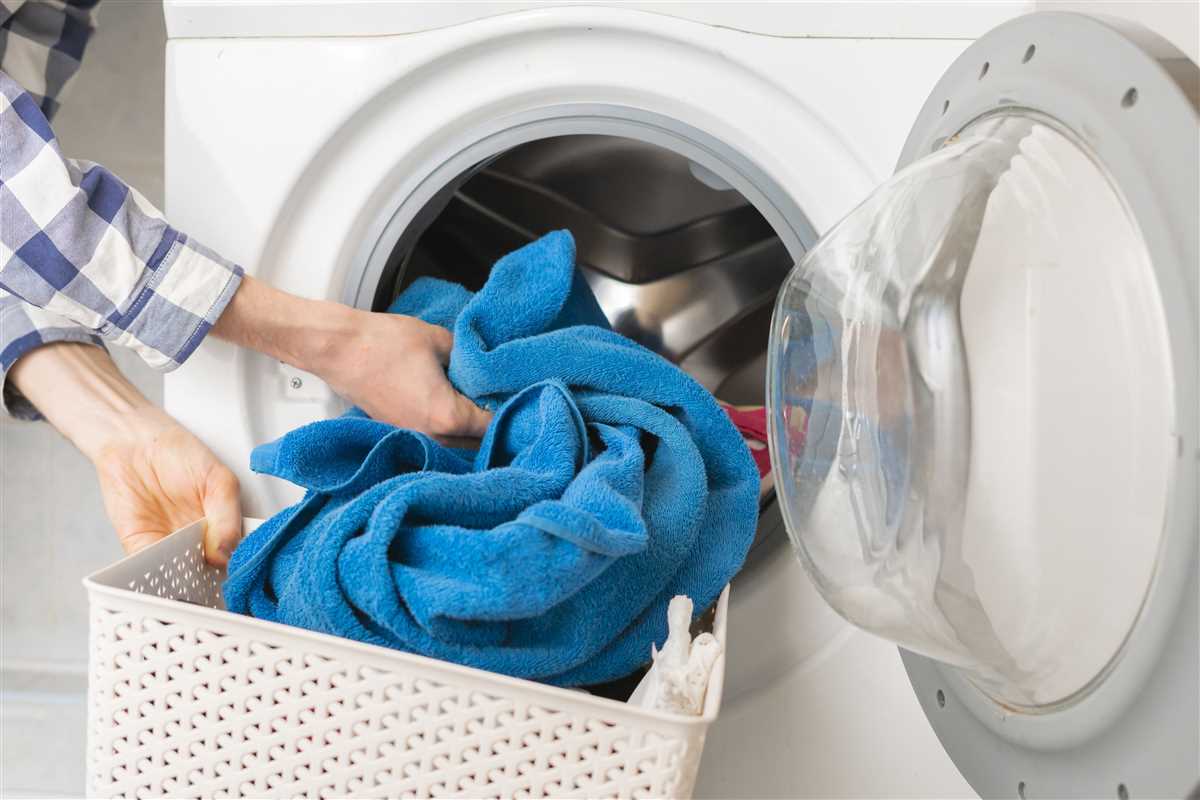




When it comes to doing laundry, one of the common questions that arise is how many towels can fit in a washing machine. This is an important consideration, especially if you have a large family or frequently use towels.
The maximum number of towels that can fit in a washing machine depends on several factors. Firstly, it depends on the size of the washing machine itself. Most washing machines come in different capacities, typically measured in kilograms or pounds. The larger the capacity, the more towels you can fit in. However, it is important to note that overloading the machine can negatively impact the cleaning efficiency and even damage your washing machine.
Additionally, the thickness and size of the towels also play a significant role in determining the maximum number that can fit. Thicker towels take up more space, so you may not be able to fit as many compared to thinner towels. Similarly, large bath towels will occupy more space than smaller hand towels or washcloths.
It is also important to consider the washing instructions provided by the manufacturer. Some towels require more space to ensure proper agitation and thorough cleaning. Overloading the machine can result in inadequate cleaning and may leave your towels feeling less fresh and clean.
In conclusion, the maximum number of towels that can fit in a washing machine depends on the size of the machine, the thickness and size of the towels, and the manufacturer’s instructions. It is essential to strike a balance between maximizing the machine’s capacity and ensuring proper cleaning for fresh and clean towels after every wash.
The Importance of Washing Machines in Our Daily Lives
Washing machines have become an integral part of our daily lives, simplifying the task of doing laundry and saving us valuable time and energy. These appliances have revolutionized the way we clean our clothes, offering convenience and efficiency like never before.
Saves Time and Effort:
Before the invention of washing machines, doing laundry was a time-consuming and labor-intensive task. Clothes had to be washed by hand, a process that required scrubbing, rinsing, and wringing out each garment individually. With a washing machine, the entire laundry process is automated. You simply load the machine with your clothes, add detergent, and press a button. The machine takes care of the rest, washing, rinsing, and spinning-drying the clothes with minimal effort on your part.
Efficient Cleaning:
Washing machines are designed to provide efficient cleaning results. They use a combination of water, detergent, and mechanical action to remove dirt, stains, and odors from clothes. The agitator or drum in the machine helps dislodge dirt particles, while the spinning action helps remove excess water, leaving the clothes clean and ready to be dried.
Preserves Clothes:
Washing machines are designed to be gentle on clothes, reducing wear and tear caused by manual washing. The rotation and movement of the clothes inside the machine are carefully controlled to prevent excessive stretching or damaging delicate fabrics. Additionally, most modern washing machines offer a variety of special cycles and settings that cater to different fabric types, ensuring that your clothes are treated with care.
Saves Water and Energy:
Traditional methods of washing clothes by hand often require large amounts of water, leading to wastage. Washing machines are designed to use less water while providing efficient cleaning. In addition, most modern models are energy-efficient, using advanced technology to reduce electricity consumption. This not only saves resources but also reduces utility bills, making washing machines an environmentally friendly choice.
Convenience and Flexibility:
With a washing machine at home, you have the convenience and flexibility to do laundry whenever it fits your schedule. You are not dependent on the availability of manual labor or laundromats. This allows you to save time and money while maintaining clean and hygienic clothes for you and your family.
In conclusion, washing machines have greatly improved our daily lives by simplifying the task of doing laundry. With their time-saving capabilities, efficient cleaning, and gentle treatment of clothes, they have become an indispensable appliance in households around the world.
Factors Affecting the Capacity of a Washing Machine

When it comes to determining the maximum number of towels that can fit in a washing machine, there are several factors that can affect its capacity. Some of the key factors include:
- Physical Size: The physical size of the washing machine plays a significant role in its capacity. Larger washing machines generally have more space inside to accommodate a larger number of towels. It’s important to consider the dimensions of the washing machine when determining its capacity.
- Drum Size: The size of the drum or tub inside the washing machine is another important factor. Washing machines with larger drums have a higher capacity and can fit more towels. The capacity of the washing machine is usually expressed in terms of weight or volume of laundry it can hold.
- Load Type: The type of load being washed can also affect the capacity of the washing machine. Different types of laundry, such as towels, bedding, or clothing, may have different sizes and weights. Bulkier items like towels may take up more space in the drum, reducing the overall capacity.
- Efficiency: High-efficiency washing machines are designed to use less water and energy, which can affect their capacity. These machines often have smaller drums compared to traditional top-loaders, resulting in a lower capacity for towels or other bulky items.
- Cycle Selection: The chosen wash cycle can also impact the capacity of the washing machine. Some cycles may require more water or have different agitation settings, which can affect the amount of laundry that can be processed at once. It’s important to consider the specific cycle requirements when determining the capacity.
In conclusion, the capacity of a washing machine depends on various factors, including its physical size, drum size, load type, efficiency, and cycle selection. Understanding these factors can help determine the maximum number of towels or other items that can fit in a washing machine.
The Size and Dimensions of the Washing Machine
When determining the maximum number of towels that can fit in a washing machine, it’s important to consider the size and dimensions of the machine. Washing machines come in different sizes and have varying capacities, which can affect the number of towels that can be comfortably accommodated.
Capacity

The capacity of a washing machine is measured in kilograms (kg) and refers to the maximum weight of laundry that can be loaded into the machine. This weight includes the towels, water, and detergent. It is important to check the capacity of your specific washing machine to determine how many towels it can accommodate.
Dimensions

In addition to capacity, the physical dimensions of the washing machine also play a role in determining the number of towels it can hold. The width, height, and depth of the machine’s drum or tub will determine the overall space available for the towels.
Some washing machines may have smaller dimensions, making them suitable for apartments or homes with limited space. Others may have larger dimensions, providing more room for larger loads of laundry, including towels. It’s essential to take into account the dimensions of the machine to ensure that the towels can fit comfortably without overcrowding the drum.
Additional Factors
While capacity and dimensions are important factors to consider, there are also additional aspects that can affect the number of towels that can fit in a washing machine:
- The thickness and size of the towels: Thicker towels will take up more space in the drum, reducing the number of towels that can be washed at once.
- The washing machine’s settings: Some machines have different settings such as load size or water level, which can affect the number of towels that can be washed in a single load.
- Overloading: It is important not to overload the washing machine to ensure proper cleaning and avoid damage to the machine. Always refer to the manufacturer’s guidelines for maximum load capacity.
Conclusion
When determining the maximum number of towels that can fit in a washing machine, it is essential to consider both the capacity and dimensions of the machine. By understanding these factors and taking into account additional considerations, such as towel thickness and machine settings, you can ensure that your towels are washed effectively and efficiently.
The Type of Washing Machine and its Features
When it comes to determining the maximum number of towels that can fit in a washing machine, it is important to consider the type of washing machine you have. Different types of washing machines have different capacities and features that impact the amount of laundry they can accommodate. Here are some common types of washing machines and their key features:
1. Top-loading washing machines:

- These are the most traditional and common type of washing machines.
- They have a vertical drum and a lid on the top for loading and unloading laundry.
- Top-loading washing machines generally have larger capacities compared to front-loading machines.
- Their capacities typically range from 3 to 5 cubic feet.
- They often have agitators, which can take up space in the drum and reduce the total laundry capacity.
2. Front-loading washing machines:
- Front-loading washing machines have gained popularity in recent years.
- They have a horizontal drum and a door on the front for loading and unloading laundry.
- Front-loading washing machines generally have smaller capacities compared to top-loading machines.
- Their capacities typically range from 2 to 4 cubic feet.
- Front-loading machines do not have agitators, allowing for more space in the drum and higher laundry capacity.
3. High-efficiency (HE) washing machines:
- HE washing machines are designed to be more energy-efficient and use less water.
- They can be either top-loading or front-loading machines.
- HE washing machines typically have larger capacities compared to traditional machines of the same size.
- They often feature advanced technologies, such as sensors and automatic load balancing, to optimize performance and efficiency.
- HE washing machines may require the use of specially-formulated HE detergent for best results.
4. Compact washing machines:
- Compact washing machines are smaller in size and ideal for small spaces, such as apartments or RVs.
- They can be either top-loading or front-loading machines.
- Compact washing machines generally have smaller capacities compared to standard-sized machines.
- Their capacities typically range from 1 to 2.5 cubic feet.
- Despite their smaller size, compact washing machines can still effectively clean a moderate amount of laundry.
It is important to consult the user manual or product specifications of your washing machine to determine its specific capacity. Overloading a washing machine can affect its performance and cleaning effectiveness. Additionally, factors like the thickness and size of the towels can also influence the maximum number of towels that can fit in a washing machine. It is always recommended to follow the manufacturer’s guidelines for optimal performance and efficiency.
Calculating the Maximum Number of Towels that can Fit

When loading a washing machine with towels, it’s important to ensure that the machine is not overfilled. Overloading a washing machine can impact the cleaning efficiency and can potentially damage the machine. Therefore, it’s crucial to calculate the maximum number of towels that can fit in the washing machine.
Step 1: Determine the Size of the Washing Machine

The first step is to determine the size of the washing machine in terms of its drum capacity. Washing machine sizes can vary, but they are typically measured in kilograms or cubic feet.
Step 2: Check the Washer’s User Manual
Consult the user manual or manufacturer’s specifications to find the maximum weight capacity or number of towels recommended for the specific washing machine model. This information will provide a good starting point for calculating the maximum number of towels that can fit.
Step 3: Consider the Type and Thickness of Towels
The type and thickness of the towels will affect how much space they occupy in the washing machine. For example, thick bath towels will take up more space compared to thinner hand towels or washcloths. It’s important to take these factors into account when calculating the maximum number of towels that can fit.
Step 4: Calculate the Available Space
Measure the dimensions of the washing machine’s drum to calculate the available space. Multiply the length, width, and height of the drum to determine its total volume.
Step 5: Estimate the Towel Volume
Estimate the volume of an average towel by multiplying its length, width, and thickness. This will give an approximate volume for one towel.
Step 6: Divide the Available Space by the Towel Volume
Divide the total volume of the washing machine drum by the approximate volume of one towel. This will give an estimate of the maximum number of towels that can fit.
Step 7: Consider Other Factors
Keep in mind that other factors may impact the maximum number of towels that can fit, such as the presence of other garments or items in the load, the washing machine’s agitation style, and the desired level of cleanliness. It’s always best to err on the side of caution and not overload the washing machine.
By following these steps, it is possible to calculate the maximum number of towels that can fit in a washing machine and ensure a successful and efficient laundry cycle.
The Weight and Volume of Towels
Towels come in various sizes and thicknesses, which affects their weight and volume. These factors play a significant role in determining the maximum number of towels that can fit in a washing machine.
Weight:
The weight of a towel depends on its size, fabric, and level of thickness. Different types of towels, such as bath towels, hand towels, and washcloths, have varying weights. Bath towels are usually heavier compared to hand towels and washcloths due to their larger size.
Volume:
The volume of a towel is determined by its dimensions when unfolded. Towels with larger dimensions have more volume, taking up more space in the washing machine.
Considerations for fitting maximum towels:
When determining the maximum number of towels that can fit in a washing machine, it is essential to consider both weight and volume. While a washing machine may have physical space to accommodate a certain number of towels, its weight limit should be taken into account.
Weight limit:
Every washing machine has a weight limit specified by the manufacturer. This weight limit indicates the maximum weight of laundry that the machine can handle. It is crucial not to exceed this weight limit to avoid damaging the washing machine.
Volume limit:
The volume limit of a washing machine refers to the available space inside the drum. Even if the towels’ weight does not exceed the machine’s weight limit, it is necessary to consider the volume limit to ensure proper water circulation and efficient washing.
Determining the maximum number of towels:
To determine the maximum number of towels that can fit in a washing machine, it is advisable to consult the machine’s user manual or contact the manufacturer directly. They can provide specific guidance on weight and volume limits, considering the machine’s specifications.
Conclusion:
When it comes to fitting towels in a washing machine, their weight and volume are crucial factors. Understanding the weight and volume limits of both the towels and the machine ensures efficient washing and prevents any potential damage or malfunction.
The Space Occupied by Towels in the Washing Machine
Towels are essential items when it comes to personal hygiene and cleanliness. They need to be washed regularly to maintain their freshness and absorbency. However, it is important to consider how many towels can fit inside a washing machine to ensure efficient cleaning and avoid overloading the machine.
Factors Affecting the Number of Towels
Several factors need to be considered when determining the maximum number of towels that can fit in a washing machine:
- Machine Capacity: The washing machine’s capacity is a crucial factor in determining the number of towels it can accommodate. Washing machines come in various sizes, such as 5kg, 7kg, or 10kg, indicating the maximum weight of laundry they can handle. Larger capacity machines can accommodate more towels.
- Towel Size: The size of the towels also plays a significant role. Larger towels take up more space, reducing the number that can be washed in one load.
- Towel Thickness: Thick and fluffy towels occupy more space in the washing machine compared to thinner ones. The fluffiness increases when towels are newer or made from high-quality materials.
- Machine Load: It is essential to leave space for the water, detergent, and agitation needed for proper cleaning. Overloading the machine by stuffing too many towels can impact its performance and affect the cleanliness of the towels.
Calculating the Number of Towels
While it is challenging to provide an exact number of towels that can fit in a washing machine, the following guidelines can help determine a reasonable load:
- For smaller capacity machines (5-7kg), it is recommended to wash 1-3 towels per load, depending on their size and thickness.
- For medium capacity machines (8-9kg), 3-5 towels can be washed at once, considering the size and thickness.
- For larger capacity machines (10kg and above), 5-8 towels can typically fit in a single load.
Tips for Efficiently Washing Towels
To ensure optimal cleaning and prolong the lifespan of your towels, consider the following tips:
- Separate towels based on color and fabric type to avoid color bleeding and maintain their integrity.
- Avoid using too much detergent, as it can leave residue on the towels and reduce their absorbency.
- Do not overload the machine to ensure thorough cleaning and prevent excessive wear and tear on the towels.
- Use the appropriate washing cycle and temperature for the towels’ fabric type, such as cotton, microfiber, or bamboo.
- Regularly clean the washing machine to prevent any buildup of detergent or fabric softener that may affect the cleanliness of the towels.
In conclusion, the maximum number of towels that can fit in a washing machine depends on various factors, including machine capacity, towel size, and thickness. It is important to follow the guidelines provided by the machine manufacturer and consider the load capacity to ensure efficient cleaning and maintain the integrity of the towels.
FAQ
What is the maximum number of towels that can fit in a standard washing machine?
The maximum number of towels that can fit in a standard washing machine depends on the size of the machine. However, on average, a standard washing machine can typically fit around 8-10 bath towels.
Can I fit more towels in a larger washing machine?
Yes, a larger washing machine will have more space, allowing you to fit more towels. Large capacity washing machines can accommodate up to 12-15 bath towels, depending on the size and dimensions of the machine.
Are there any washing machines specifically designed for washing towels?
There are no washing machines specifically designed for washing towels, but there are machines with larger drum capacities that can handle bulkier items like towels more effectively. Some washing machines also have special cycles or features, such as “heavy duty” or “bedding”, which can be used for washing towels.
What happens if I overload the washing machine with too many towels?
Overloading the washing machine with too many towels can affect the machine’s performance and efficiency. The towels may not get cleaned properly, as there won’t be enough space for the water and detergent to circulate. It can also put extra strain on the machine’s motor and other components, potentially leading to malfunctions or damage.
Is it better to wash towels in smaller loads to ensure proper cleaning?
It is generally recommended to wash towels in smaller loads to ensure proper cleaning. This allows enough space for the water and detergent to evenly distribute and effectively clean the towels. Washing towels in larger loads may result in less efficient cleaning and can potentially lead to odour and bacteria build-up.












